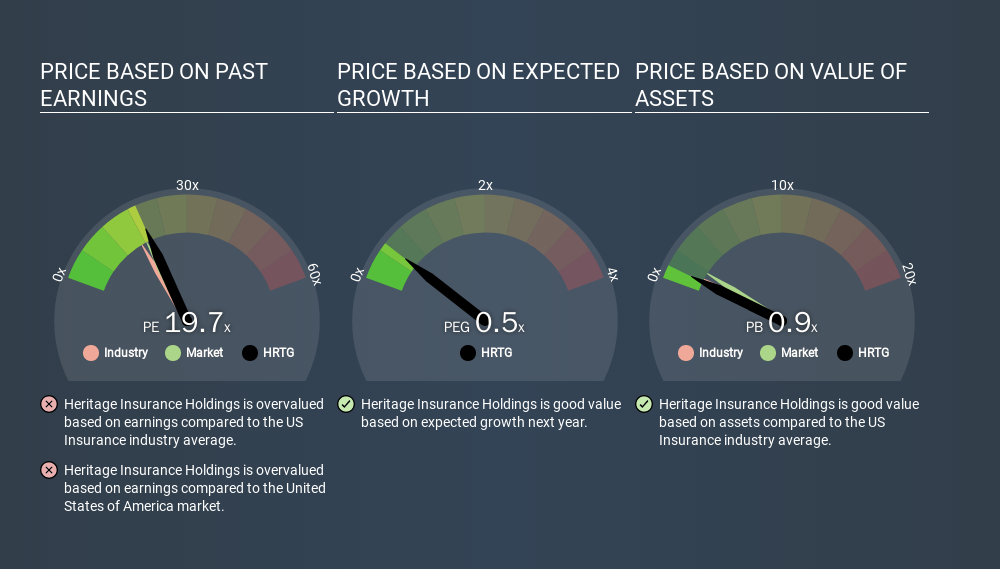- United States
- /
- Insurance
- /
- NYSE:HRTG
Should We Worry About Heritage Insurance Holdings, Inc.'s (NYSE:HRTG) P/E Ratio?

This article is written for those who want to get better at using price to earnings ratios (P/E ratios). We'll show how you can use Heritage Insurance Holdings, Inc.'s (NYSE:HRTG) P/E ratio to inform your assessment of the investment opportunity. Looking at earnings over the last twelve months, Heritage Insurance Holdings has a P/E ratio of 19.66. That corresponds to an earnings yield of approximately 5.1%.
See our latest analysis for Heritage Insurance Holdings
How Do You Calculate A P/E Ratio?
The formula for P/E is:
Price to Earnings Ratio = Share Price ÷ Earnings per Share (EPS)
Or for Heritage Insurance Holdings:
P/E of 19.66 = $13.53 ÷ $0.69 (Based on the trailing twelve months to September 2019.)
Is A High P/E Ratio Good?
A higher P/E ratio means that investors are paying a higher price for each $1 of company earnings. That isn't a good or a bad thing on its own, but a high P/E means that buyers have a higher opinion of the business's prospects, relative to stocks with a lower P/E.
How Does Heritage Insurance Holdings's P/E Ratio Compare To Its Peers?
The P/E ratio indicates whether the market has higher or lower expectations of a company. The image below shows that Heritage Insurance Holdings has a higher P/E than the average (16.5) P/E for companies in the insurance industry.

Heritage Insurance Holdings's P/E tells us that market participants think the company will perform better than its industry peers, going forward. Clearly the market expects growth, but it isn't guaranteed. So further research is always essential. I often monitor director buying and selling.
How Growth Rates Impact P/E Ratios
When earnings fall, the 'E' decreases, over time. That means even if the current P/E is low, it will increase over time if the share price stays flat. So while a stock may look cheap based on past earnings, it could be expensive based on future earnings.
Heritage Insurance Holdings saw earnings per share decrease by 4.2% last year. And it has shrunk its earnings per share by 12% per year over the last five years. So we might expect a relatively low P/E.
A Limitation: P/E Ratios Ignore Debt and Cash In The Bank
Don't forget that the P/E ratio considers market capitalization. In other words, it does not consider any debt or cash that the company may have on the balance sheet. In theory, a company can lower its future P/E ratio by using cash or debt to invest in growth.
While growth expenditure doesn't always pay off, the point is that it is a good option to have; but one that the P/E ratio ignores.
So What Does Heritage Insurance Holdings's Balance Sheet Tell Us?
Heritage Insurance Holdings has net cash of US$99m. This is fairly high at 25% of its market capitalization. That might mean balance sheet strength is important to the business, but should also help push the P/E a bit higher than it would otherwise be.
The Bottom Line On Heritage Insurance Holdings's P/E Ratio
Heritage Insurance Holdings's P/E is 19.7 which is above average (18.2) in its market. The recent drop in earnings per share might keep value investors away, but the net cash position means the company has time to improve: and the high P/E suggests the market thinks it will.
Investors should be looking to buy stocks that the market is wrong about. People often underestimate remarkable growth -- so investors can make money when fast growth is not fully appreciated. So this free visualization of the analyst consensus on future earnings could help you make the right decision about whether to buy, sell, or hold.
Of course you might be able to find a better stock than Heritage Insurance Holdings. So you may wish to see this free collection of other companies that have grown earnings strongly.
If you spot an error that warrants correction, please contact the editor at editorial-team@simplywallst.com. This article by Simply Wall St is general in nature. It does not constitute a recommendation to buy or sell any stock, and does not take account of your objectives, or your financial situation. Simply Wall St has no position in the stocks mentioned.
We aim to bring you long-term focused research analysis driven by fundamental data. Note that our analysis may not factor in the latest price-sensitive company announcements or qualitative material. Thank you for reading.
About NYSE:HRTG
Heritage Insurance Holdings
Through its subsidiaries, provides personal and commercial residential insurance products.
Outstanding track record and undervalued.
Similar Companies
Market Insights
Community Narratives


